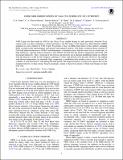| dc.contributor.author | Jenke, P. A. | |
| dc.contributor.author | Wilson-Hodge, C. A. | |
| dc.contributor.author | Homan, Jeroen | |
| dc.contributor.author | Veres, P. | |
| dc.contributor.author | Briggs, M. S. | |
| dc.contributor.author | Burns, E. | |
| dc.contributor.author | Connaughton, V. | |
| dc.contributor.author | Finger, M. H. | |
| dc.contributor.author | Hui, M. | |
| dc.date.accessioned | 2016-10-28T15:59:23Z | |
| dc.date.available | 2016-10-28T15:59:23Z | |
| dc.date.issued | 2016-07 | |
| dc.date.submitted | 2016-04 | |
| dc.identifier.issn | 1538-4357 | |
| dc.identifier.issn | 0004-637X | |
| dc.identifier.uri | http://hdl.handle.net/1721.1/105128 | |
| dc.description.abstract | V404 Cygni was discovered in 1989 by the Ginga X-ray satellite during its only previously observed X-ray outburst and soon after confirmed as a black hole binary. On 2015 June 15, the Gamma-ray Burst Monitor (GBM) triggered on a new outburst of V404 Cygni. We present 13 days of GBM observations of this outburst, including Earth occultation flux measurements and spectral and temporal analysis. The Earth occultation fluxes reached 30 Crab with detected emission to 100 keV and determined, via hardness ratios, that the source was in a hard state. At high luminosity, spectral analysis between 8 and 300 keV showed that the electron temperature decreased with increasing luminosity. This is expected if the protons and electrons are in thermal equilibrium during an outburst with the electrons cooled by the Compton scattering of softer seed photons from the disk. However, the implied seed photon temperatures are unusually high, suggesting a contribution from another source, such as the jet. No evidence of state transitions is seen during this time period. The temporal analysis reveals power spectra that can be modeled with two or three strong, broad Lorentzians, similar to the power spectra of black hole binaries in their hard state. | en_US |
| dc.language.iso | en_US | |
| dc.publisher | Institute of Physics Publishing (IOP) | en_US |
| dc.relation.isversionof | http://dx.doi.org/10.3847/0004-637x/826/1/37 | en_US |
| dc.rights | Article is made available in accordance with the publisher's policy and may be subject to US copyright law. Please refer to the publisher's site for terms of use. | en_US |
| dc.source | American Astronomical Society | en_US |
| dc.title | FERMI GBM OBSERVATIONS OF V404 CYG DURING ITS 2015 OUTBURST | en_US |
| dc.type | Article | en_US |
| dc.identifier.citation | Jenke, P. A., C. A. Wilson-Hodge, Jeroen Homan, P. Veres, M. S. Briggs, E. Burns, V. Connaughton, M. H. Finger, and M. Hui. “FERMIGBM OBSERVATIONS OF V404 CYG DURING ITS 2015 OUTBURST.” The Astrophysical Journal 826, no. 1, article 37, July 2016, pp. 1-11. © 2016 The American Astronomical Society. | en_US |
| dc.contributor.department | MIT Kavli Institute for Astrophysics and Space Research | en_US |
| dc.contributor.mitauthor | Homan, Jeroen | |
| dc.relation.journal | Astrophysical Journal | en_US |
| dc.eprint.version | Final published version | en_US |
| dc.type.uri | http://purl.org/eprint/type/JournalArticle | en_US |
| eprint.status | http://purl.org/eprint/status/PeerReviewed | en_US |
| dspace.orderedauthors | Jenke, P. A.; Wilson-Hodge, C. A.; Homan, Jeroen; Veres, P.; Briggs, M. S.; Burns, E.; Connaughton, V.; Finger, M. H.; Hui, M. | en_US |
| dspace.embargo.terms | N | en_US |
| mit.license | PUBLISHER_POLICY | en_US |
| mit.metadata.status | Complete | |
